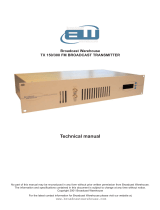
INTRODUCTION
4
A NOTE ON DISTORTION
The human hearing system unconsciously perceives minute signals both within and well beyond
the traditional audio frequency spectrum. When such frequencies that are not present in nature,
such as high order harmonics produced by amplifier distortion, or by the presence of seemingly
inaudible artifacts due to interference, or when those frequencies that are present in nature are
missing, the human hearing system "reports" what we might describe as a deviation from
faithfulness. It seems that we store a bank of information based on "natural" sound and are able,
subconsciously, to compare reproduced sound with "natural" sound.
This deviation from faithfulness gives rise to a feeling of discomfort and frustration that is very
hard to describe or to explain. However, amazingly, it can be measured! When subject to non-
faithful sound, the brain actually emits electric activity that can be measured. (See "Audible Range
Affects Brain Electric Activity and Sound Perception" (Ref: 1).
Inevitably our data bank of "natural" sound is built up on the basis of our personal experience and
this must surely emphasize the importance of listening to "natural" sound, and high quality musical
instruments within acoustic environments that is subjectively pleasing so as to develop keen
awareness that will contribute to a reliable data bank. Humans who have not experienced enough
"natural" sound may well have a flawed data bank!
The way in which an analog amplifier handles very small signals is as important as the way it
behaves at high levels. For low distortion, an analog amplifier must have a linear transfer
characteristic, in other words, the output signal must be an exact replica of the input signal,
differing only in magnitude. The magnitude can be controlled by a gain control or fader (consisting
of a high quality variable resistor that, by definition, has a linear transfer characteristic.)
A dynamics controller - i.e. a compressor, limiter or expander - is a gain control that can adjust gain
of the amplifier very rapidly in response to the fluctuating audio signal, ideally without introducing
significant distortion, i.e. it must have a linear transfer characteristic. But, by definition, rapidly
changing gain means that a signal "starting out" to be linear and, therefore without distortion, gets
changed on the way to produce a different amplitude.
In order to control gain, a V.C.A. or Voltage Controlled Amplifier (or Attenuator) is used. There are
many types of V.C.A.'s that include the use of tubes, discrete and integrated solid state circuits, or
naturally non-linear devices. Each one has its own characteristic behavior that reflects sonically on
the final performance, and, inevitably, gives it a character or signature that can be musically
attractive or - not! In order to achieve a sonically musical signature, low level signals below the
"Threshold" level at which the VCA starts to operate, must be treated linearly, to avoid low level
distortion.
1.Tsutomu Oohashi, Emi Nishina, Norie Kawai, Yoshitaka Fuwamoto, and Hishi Imai. National
Institute of Multimedia Education, Tokyo. "High Frequency Sound Above the Audible Range,
Affects Brain Electric Activity and Sound Perception" Paper read at 91st. Convention of the A.E.S.
October 1991. Section 7. (1), Conclusion.


















